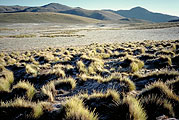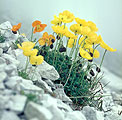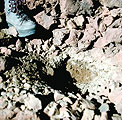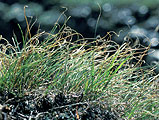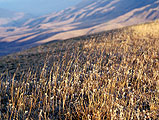 |
|
|
|
|
|
|
Don't let yourself be misguided by visual impression. |
|
|
What looks dry to us is not necessarily dry for plants! The altiplano of the subtropical Andes looks very dry, but in reality it is not particularly dry for the local set of specialist plants. It was a big surprise, when this was discovered to be the case at an altitude of 4000 m (Fig. 1). How is this possible? Plant species are able to control plant density by unknown mechanisms, with the consequence that there is enough moisture for those leaves which are eventually formed. By controlling the leaf area index (LAI, m2 of leaf surface per m2 of ground surface), plants control water consumption, so that critical desiccation is avoided. |
1 - Cumbres Calchaquies, 4250 m (northwest Argentina). Not as dry as one might think... |
|
What is often thought to be dry is in fact wet: Coarse substrate such as on scree slopes or on volcanoes can help preserve moisture in the fine substrate underneath, because of discontinued capillary water flow to the hot surface. This insulating function of loose debris together with its selective mechanical forces on plants (which are tolerated by a few specialists only) makes scree slopes in the Alps become wet habitats for those which can resist those forces. |
|
2 - Papaver rhaeticum |
3 - Volcanic cinders on Mt. Teide |
|
Alpine mats often look dry, but they are not. What makes these alpine heathlands look dry is the brown colour of dead leaf ends from the previous year. These are wind breaks and help to trap warmth in the green canopy underneath. Very similar "brownish" alpine grassland occurs worldwide. The brown colour is not related to water shortage, but reflects the longevity of dead leaf material in alpine climates. |
|
4 - Carex curvula (Swiss Alps, 2600 m) |
5 - Chionochloa grasslands in New Zealand (2000 m) |
6 - Kobresia grasslands with Leontopodium (Tien Shan, central Asia, 2600 m) |
|
Mini-deserts are, however, found on most mountains: When soil is lacking, almost any place on earth can become a periodic desert... bare rock! This is the world of desiccation tolerant plants, most of which belong to the cryptogams: bryophytes, lichens and algae. |
7 - A rich ecosystem of bryophytes, lichens and algae on a rock surface. |
29 August 2011 |
||
| |
||
